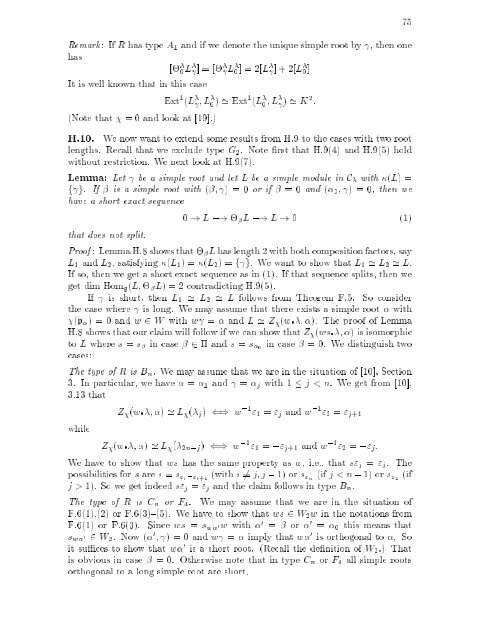subregular nilpotent representations of lie algebras in prime ...
subregular nilpotent representations of lie algebras in prime ...
subregular nilpotent representations of lie algebras in prime ...
You also want an ePaper? Increase the reach of your titles
YUMPU automatically turns print PDFs into web optimized ePapers that Google loves.
Remark: IfR has type A1 and if we denote the unique simple root by , then one<br />
has<br />
[ 0L ]=[ L 0]=2[L ]+2[L 0]<br />
It is well known that <strong>in</strong> this case<br />
(Note that = 0 and look at [19].)<br />
Ext 1 (L ;L 0) ' Ext 1 (L 0;L ) ' K 2 :<br />
H.10. We nowwant to extend some results from H.9 to the cases with two root<br />
lengths. Recall that we exclude type G2. Note rst that H.9(4) and H.9(5) hold<br />
without restriction. We next look at H.9(7).<br />
Lemma: Let be a simple root and let L be a simple module <strong>in</strong> C with (L) =<br />
f g. If is a simple root with ( ; )=0or if =0and ( 0; )=0,thenwe<br />
have a short exact sequence<br />
that does not split.<br />
0 ! L ,! L ,! L ! 0 (1)<br />
Pro<strong>of</strong> : Lemma H.8 shows that L has length 2 with both composition factors, say<br />
L1 and L2, satisfy<strong>in</strong>g (L1) = (L2) =f g. Wewant toshow that L1 ' L2 ' L.<br />
If so, then we get a short exact sequence as <strong>in</strong> (1). If that sequence splits, then we<br />
get dim Homg(L; L) = 2 contradict<strong>in</strong>g H.9(5).<br />
If is short, then L1 ' L2 ' L follows from Theorem F.5. So consider<br />
the case where is long. We may assume that there exists a simple root with<br />
(p )=0andw 2 W with w = and L ' Z (w ; ). The pro<strong>of</strong> <strong>of</strong> Lemma<br />
H.8 shows that our claim will follow ifwe can show that Z (ws ; ) is isomorphic<br />
to L where s = s <strong>in</strong> case 2 and s = s 0 <strong>in</strong> case =0. We dist<strong>in</strong>guish two<br />
cases:<br />
The type <strong>of</strong>R is Bn. We may assume that we are <strong>in</strong> the situation <strong>of</strong> [10], Section<br />
3. In particular, we have = 1 and = j with 1 j1). So we get <strong>in</strong>deed s"j = "j and the claim follows <strong>in</strong> type Bn.<br />
The type <strong>of</strong> R is Cn or F4. We may assume that we are <strong>in</strong> the situation <strong>of</strong><br />
F.6(1),(2) or F.6(3){(5). We have to show that ws 2 W2w <strong>in</strong> the notations from<br />
F.6(1) or F.6(3). S<strong>in</strong>ce ws = sw 0w with 0 = or 0 = 0 this means that<br />
sw 0 2 W2. Now( 0 ; ) = 0 and w = imply that w 0 is orthogonal to . So<br />
it su ces to show that w 0 is a short root. (Recall the de nition <strong>of</strong> W2.) That<br />
is obvious <strong>in</strong> case = 0. Otherwise note that <strong>in</strong> type Cn or F4 all simple roots<br />
orthogonal to a long simple root are short.<br />
75

















